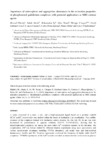Mostrar o rexistro simple do ítem
Importance of outer-sphere and aggregation phenomena in the relaxation properties of phosphonated gadolinium complexes with potential applications as MRI contrast agents
| dc.contributor.author | Elhabiri, Mourad | |
| dc.contributor.author | Abada, Sabah | |
| dc.contributor.author | Sy, Mohamadou | |
| dc.contributor.author | Nonat, Aline | |
| dc.contributor.author | Choquet, Philippe | |
| dc.contributor.author | Esteban-Gómez, David | |
| dc.contributor.author | Cassino, Claudio | |
| dc.contributor.author | Platas-Iglesias, Carlos | |
| dc.contributor.author | Botta, Mauro | |
| dc.contributor.author | Charbonnière, Loïc J. | |
| dc.date.accessioned | 2017-10-27T13:34:23Z | |
| dc.date.available | 2017-10-27T13:34:23Z | |
| dc.date.issued | 2015-04-10 | |
| dc.identifier.citation | Elhabiri, M., Abada, S., Sy, M., Nonat, A., Choquet, P., Esteban-Gómez, D., Cassino, C., Platas-Iglesias, C., Botta, M. and Charbonnière, L. J. (2015), Importance of outer-sphere and aggregation phenomena in the relaxation properties of phosphonated gadolinium complexes with potential applications as MRI contrast agents. Chem. Eur. J., 21: 6535–6546. | es_ES |
| dc.identifier.issn | 0947-6539 | |
| dc.identifier.issn | 1521-3765 | |
| dc.identifier.uri | http://hdl.handle.net/2183/19649 | |
| dc.description.abstract | [Abstract] A series composed of a tetra-, a tris- and a bisphosphonated ligand based on a pyridine scaffold (L4, L3 and L2, respectively) was studied within the frame of lanthanide (Ln) coordination. The stability constants of the complexes formed with lanthanide cations (Ln=La, Nd, Eu, Gd, Tb, Er and Lu) were determined by potentiometry in aqueous solutions (25.0 °C, 0.1 M NaClO4), showing that the tetraphosphonated complexes are among the most stable LnIII complexes reported in the literature. The complexation of L4 was further studied by different titration experiments using mass spectrometry and various spectroscopic techniques including UV/Vis absorption, and steady state and time-resolved luminescence (Ln=Eu and Tb). Titration experiments confirmed the formation of highly stable [LnL4] complexes. 31P NMR experiments of the LuL4 complex revealed an intramolecular interconversion process which was studied at different temperatures and was rationalized by DFT modelling. The relaxivity properties of the GdIII complexes were studied by recording their 1H NMRD profiles at various temperatures, by temperature dependent 17O NMR experiments (GdL4) and by pH dependent relaxivity measurements at 0.47 T (GdL3 and GdL2). In addition to the high relaxivity values observed for all complexes, the results showed an important second-sphere contribution to relaxivity and pH dependent variations associated with the formation of aggregates for GdL2 and GdL3. Finally, intravenous injection of GdL4 to a mouse was followed by dynamic MRI imaging at 1.5 T, which showed that the complex can be immediately found in the blood stream and rapidly eliminated through the liver and in large part through the kidneys. | es_ES |
| dc.description.sponsorship | Torino. Compagnia di San Paolo; CSP-2012 NANOPROGLY | es_ES |
| dc.language.iso | eng | es_ES |
| dc.publisher | Wiley | es_ES |
| dc.relation.uri | https://doi.org/10.1002/chem.201500155 | es_ES |
| dc.rights | This is the peer reviewed version of the following article: Elhabiri, M., Abada, S., Sy, M., Nonat, A., Choquet, P., Esteban-Gómez, D., Cassino, C., Platas-Iglesias, C., Botta, M. and Charbonnière, L. J. (2015), Importance of outer-sphere and aggregation phenomena in the relaxation properties of phosphonated gadolinium complexes with potential applications as MRI contrast agents. Chem. Eur. J., 21: 6535–6546, which has been published in final form at https://doi.org/10.1002/chem.201500155. This article may be used for non-commercial purposes in accordance with Wiley Terms and Conditions for Self-Archiving. | es_ES |
| dc.subject | Imaging agents | es_ES |
| dc.subject | Lanthanides | es_ES |
| dc.subject | Luminescence | es_ES |
| dc.subject | Phosphonate | es_ES |
| dc.subject | Relaxivity | es_ES |
| dc.title | Importance of outer-sphere and aggregation phenomena in the relaxation properties of phosphonated gadolinium complexes with potential applications as MRI contrast agents | es_ES |
| dc.type | info:eu-repo/semantics/article | es_ES |
| dc.rights.access | info:eu-repo/semantics/openAccess | es_ES |
| UDC.journalTitle | Chemistry - A European Journal | es_ES |
| UDC.volume | 21 | es_ES |
| UDC.issue | 17 | es_ES |
| UDC.startPage | 6535 | es_ES |
| UDC.endPage | 6546 | es_ES |
Ficheiros no ítem
Este ítem aparece na(s) seguinte(s) colección(s)
-
GI-REACT! - Artigos [113]






